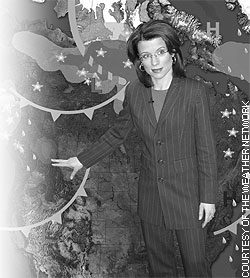A Change in the Weather
Not long ago, viewers tuned in to see if they needed an umbrella. Today, they expect an updated forecast every ten minutes. Can broadcasters deliver?
An empty studio desk at the Weather Network headquarters in Oakville, Ontario never stays empty for long. Within seconds, it becomes scattered with lipstick-stained coffee cups, maps of Canada and piles of meteorological data printouts. Suzanne Leonard Feliz, the afternoon program host, leans forward, pen poised over her maps, listening as the studio meteorologist on the other side of the desk briefs her on the latest conditions across the country. Five computer monitors glow with radar and satellite images, showing current fronts, plotted temperatures and precipitation for Atlantic Canada. “This is a big country, where weather is always changing,” explains Feliz. “There’s a lot to learn as a presenter and a lot of responsibility as you’re passing along this information. It’s not just talking for a living – it’s talking, focusing, listening, concentrating, remembering, targeting and compiling. You’re making journalistic decisions all the time whenever you’re live.”
A survey of 3,000 people conducted by Ipsos-Reid and the Weather Network in 2004 showed that more than eighty per cent of adults go out of their way to check the daily forecast. (An Environment Canada survey produced similar statistics.) With those numbers, it’s clear that weather broadcasters have a responsibility to break down complex meteorological data and deliver the weather in a journalistic fashion that strives to be accessible, timely, newsworthy and, above all, accurate.
Weather reporting has come a long way since September 8, 1952, when Percy Saltzman not only became the first person to appear on English television in Canada, but also the first weatherman. As part of the British Commonwealth Air Training Plan during the Second World War, Saltzman prepared forecasts under the direction of the Meteorological Division of the Department of Transport and taught meteorology to air crews.

The Weather Network’s Suzanne Leonard Feliz today uses a green screen
Though he was more than qualified to explain the weather to a national audience, it wasn’t easy to convince CBLT-TV, now CBC Toronto, of that fact. In early 1952, newspapers began printing announcements that Canada was headed for television and Saltzman sent a proposal to the station. “They didn’t think weather had a place,” recalls the 91-year-old, with a smile. “Who would want to watch a guy, a talking head, talk about the weather: the most boring thing in the world? That was their view then. They also had that same view about news. They said, ‘We’re not going to have news on television. Who wants to watch a talking head talk about news? Boring!’ Of course, they were wrong on both counts.”
But news directors began to see weather as an integral part of the newscast. Gradually, weather broadcasters evolved from reciters of Environment Canada forecasts to broadcasters with meteorological training. Advancements in technology, including the Doppler radar, which converts radio waves into images, and the U.S.-based WSI weather system with high-resolution satellite imagery used by CTV, CNN and NBC, have provided increasingly accurate forecasts.
 “It’s never going to be an exact science,” says Sylvia Kuzyk, co-host and weather reporter for CTV News in Winnipeg. “Now we have a tremendous wealth of tools at our disposal and it’s a more high-tech job. People are demanding good weather information.” That’s why Frank Cavallaro is known for fighting for more on-air time. Whenever CTV Montreal’s weather presenter is brushed aside for wanting to increase weather coverage, he pulls out his secret weapon: a copy of a 2004 article from The Cincinnati Enquirer that quotes a journalism assistant professor at the E.W. Scripps School of Journalism at Ohio University in Athens as saying, “The No. 1 reason people watch local news is for the weather. It’s the one story that affects everybody.”
“It’s never going to be an exact science,” says Sylvia Kuzyk, co-host and weather reporter for CTV News in Winnipeg. “Now we have a tremendous wealth of tools at our disposal and it’s a more high-tech job. People are demanding good weather information.” That’s why Frank Cavallaro is known for fighting for more on-air time. Whenever CTV Montreal’s weather presenter is brushed aside for wanting to increase weather coverage, he pulls out his secret weapon: a copy of a 2004 article from The Cincinnati Enquirer that quotes a journalism assistant professor at the E.W. Scripps School of Journalism at Ohio University in Athens as saying, “The No. 1 reason people watch local news is for the weather. It’s the one story that affects everybody.”
While neither Kuzyk nor Cavallaro holds a degree in meteorology, both have presented the weather for so long (twenty-five and eighteen years, respectively) and gained such extensive backgrounds that it comes as naturally to them as if they were certified meteorologists – which is one hope for Dr. Neil Campbell. In 1994, the former executive director of the Canadian Meteorological and Oceanographic Society (CMOS) helped introduce a program that endorses broadcasters who have meterorological training, a meteorology degree, or professional broadcast training with sufficient knowledge in meteorology to present weather in a scientifically correct manner. “Back then, stations didn’t care about the weather – it was pared down to a few seconds on air,” remarks Campbell. “But CMOS members were complaining about the weather quality on television, that people were just reciting the forecast without really understanding what they were talking about.” Over the years, almost fifty Canadian broadcasters have met the CMOS endorsement criteria for high quality weather presentation – Kuzyk and Cavallaro included.
Regardless of their educational backgrounds, weather broadcasters, like journalists, must be good communicators. They aren’t just spewing scientific jargon about jet streams and dewpoints – they’re educators of meteorological knowledge. “How many times have you watched a weather forecast wanting to know whether it was going to rain the next day, and when the forecast was over, you still didn’t know?” asks Paul Rogers, vice-president of news and news director at CTV Toronto. “The green blob on weather maps is just a green blob until someone can explain it to you.”
Though U.S. networks generally hire meteorologists, a symptom of the wide range of extreme weather in that country, the same isn’t true on this side of the border. “Some meteorologists don’t work on TV,” explains Ian Haysom, news director at Global B.C. “If I had an opening, it really would depend on the person. The audience has to believe weather people have the knowledge.”
When Campbell began the CMOS endorsement program, he discovered that broadcasters with meteorological training were often more successful at delivering a forecast than meteorologists, some of whom were “so dry and technical that no one could follow them.”
But Campbell also stresses the importance of a broadcaster having a solid weather background, and with stations such as the Weather Network, which offers extensive, inhouse meteorological training, he says credentials are fundamental to the profession. And, in times of severe weather, having a knowledgeable on-air personality who can immediately explain the scientific cause behind a weather event is far more efficient for the station and helpful for the viewers.
That’s one reason why on-air meteorologists are valuable assets for networks. Meteorologist Chris Scott, co-host of the Weather Network’s national evening program, grew up watching the U.S.-based Weather Channel on satellite. In states such as Florida, which are prone to severe weather, he says meteorologists are crucial in the interpretation of data to deliver the necessary safety information to viewers. Before a hurricane, for example, a meteorologist can track the storm’s path and give people ample time to prepare, or even evacuate, before it hits. With increasingly advanced weather information available to the public, the demand for more specific information will become greater over time.
“We’re not going to see it being all scientists on air, but you’ll see more of them in the future,” says Scott, who holds a master’s degree in atmospheric science. “People are getting more educated about meteorology, and they have a little bit more hunger for the in-depth information.”
And when it comes to satisfying that craving, weather broadcasters are serious about having the same high standards as news reporters. Like any reputable journalist, weather people arrive at the station hours before broadcasting to prepare the forecast, checking for breaking news and updates right until the final seconds before airtime. In fact, the weather often becomes the news. When that happens, news reporters may take over the story, but weather broadcasters still play a vital role in deconstructing important meteorological angles of what’s happening before, during and after the weather event.
Mike Piperni, news director of CTV Montreal, calls the ice storm of 1998 that hit parts of eastern Ontario, Quebec and New Brunswick, a “significant moment of weather in this province that really put weather on the map.” Weather-related reports were leading each newscast at the time. “Weather people were working as reporters, as journalists, going to local shelters,” recalls CTV Montreal’s Cavallaro, “but we also had to do our own work, like explain the cause of all the freezing rain.”
The simple fact that forecasters can see what’s coming well before it hits gives media outlets the opportunity to provide the public with vital information, including local area weather warnings and the impact of the severe weather on the public. Environment Canada senior climatologist David Phillips says the media do a tremendous job of this, but there is also the real danger of over-dramatizing the weather. “Information should be played, not hyped,” he says. “There’s a sensational way and an authoritative, reliable way. You can’t always trust the public to know what’s right and wrong.”
And with a history of weather broadcasters’ fondness for gimmicks, achieving authority can sometimes be a challenge. Cavallaro hosts the Great Zucchini Challenge in early autumn, in which viewers send in photos of large or oddly shaped zucchinis. “It began as a joke,” he says. “Once I brought this five-footlong zucchini into the station from my grandfather, who said the right amount of sun and rain will give you a great zucchini. And when people told Cavallaro they didn’t grow zucchinis – they grew tomatoes – he started another contest called Show Us Your Tomatoes.
Early in her weather career, CTV Winnipeg’s Kuzyk swung onto the studio set on a tire swing. Tamara Taggart, of CTV Vancouver, has been known to chase pigs, milk cows and deliver the forecast while cooking dinner at a viewer’s home. She was also named best TV weather person and best TV personality by Vancouver’s Georgia Straight in its annual readers poll from 2002 to 2004. While such antics may make for fun viewing, the real challenge is to have personality without the gimmicks, and that’s a balance that successful weather broadcasters have reached. “It’s important to be fun and accessible but not goofballs,” says Global B.C. news director Ian Haysom.
 This past Halloween, Global Ontario’s Michael Kuss donned a cloud costume with a sun-shaped hat while delivering his forecast, but aside from the occasional exception of a fun holiday, he remains engagingly informative on a daily basis without the props. “There isn’t always a lot going on, so you have to have fun,” admits Kuss, who says gimmicks are becoming a trend of the past. “The station isn’t going to show a politics story if there’s no story in politics, but we will always have to show the weather.”
This past Halloween, Global Ontario’s Michael Kuss donned a cloud costume with a sun-shaped hat while delivering his forecast, but aside from the occasional exception of a fun holiday, he remains engagingly informative on a daily basis without the props. “There isn’t always a lot going on, so you have to have fun,” admits Kuss, who says gimmicks are becoming a trend of the past. “The station isn’t going to show a politics story if there’s no story in politics, but we will always have to show the weather.”
Despite the strides weather broadcasters have made in being seen as real journalists, there will always be those who disagree, even  among their own ranks. “Weather is not large-J journalism, it’s a smaller-J journalism,” says Zack Spencer, weather anchor for the morning news at Global B.C., who prefers a more down-to-earth approach instead of an emphasis on maps and weather graphics, which he says detracts from the forecast rather than enhances it. “While it’s all those things about affecting people, being timely and accurate as possible, at the end of the day, it’s just the weather.”
among their own ranks. “Weather is not large-J journalism, it’s a smaller-J journalism,” says Zack Spencer, weather anchor for the morning news at Global B.C., who prefers a more down-to-earth approach instead of an emphasis on maps and weather graphics, which he says detracts from the forecast rather than enhances it. “While it’s all those things about affecting people, being timely and accurate as possible, at the end of the day, it’s just the weather.”
But for Feliz, the weather is a journalistic story that Canadians want – and need – to know, and for the eight years she’s been at the Weather Network, she’s delivered that story five days a week. “Some pers-para-pre-bleh! Perpetual precip. Precipitation! Too many Ps in that sentence!” Feliz smiles, shrugging off her on-screen error, and finishes the rest of her sentence with ease. In a matter of minutes, the CMOS-endorsed weather broadcaster has run through the country’s forecast, including current temperatures, precipitation, isobar lines and an indication of where snow will fall from coast to coast.
With the cameras off, Feliz steps away from her spot in front of the green screen flanked by trios of TV monitors and relaxes at the studio desk. “You have to remember what’s important to people and what it all means,” she says. “If you can connect with people and give them the straight goods and the information they need in a timely and effective fashion, and it’s accurate, then you’re off to the races.”
Emily Claire Afan was the Production Editor for the Spring 2006 issue of the Ryerson Review of Journalism.












































